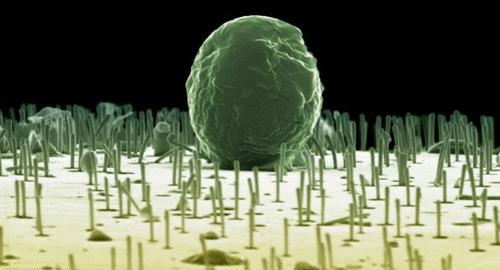无光刻水稳定导电聚合物纳米线
IF 9.1
1区 材料科学
Q1 CHEMISTRY, MULTIDISCIPLINARY
引用次数: 0
摘要
独立的纳米线可以在不引起应激或细胞凋亡的情况下进入细胞内。目前产生纳米线的方法主要集中在光刻图像化和无机材料(Si, GaAs, Al2O3等)上,而有机材料的探索较少。有机导电聚合物的使用允许创建软混合离子-电子导电纳米线。由于使用苛刻的化学物质和加工条件,将导电聚合物加工成纳米线具有挑战性。在这里,我们展示了一种无光刻和可扩展的方法来生成由导电聚合物组成的全有机,水稳定的纳米线。纳米多孔膜在溶液中填充导电聚合物,然后通过交联步骤使聚合物具有水稳定性。利用活性离子蚀刻器对膜表面进行各向异性蚀刻,以显示孔隙内的聚合物,这些聚合物从膜上延伸出来,形成纳米线。我们将纳米线与模型藻细胞、人原代造血干细胞和祖细胞相连接。本文章由计算机程序翻译,如有差异,请以英文原文为准。

Lithography-Free Water Stable Conductive Polymer Nanowires
Free-standing nanowires can gain intracellular access without causing stress or apoptosis. Current approaches to generate nanowires focus on lithographic patterning and inorganic materials (Si, GaAs, Al2O3, etc.) while organic materials are less explored. Use of organic conductive polymers allows for the creation of soft mixed ion–electron conducting nanowires. Processing conductive polymers into nanowires is challenging due to the harsh chemicals and processing conditions used. Here, we demonstrate a lithography-free and scalable method to generate all-organic, water-stable nanowires composed of conductive polymers. A nanoporous membrane is filled with conductive polymer in solution, followed by a cross-linking step to make the polymer water stable. The surface of the membrane is anisotropically etched using a reactive ion etcher to reveal the polymer inside the pores, which extends from the membrane as nanowires. We interface the nanowires with model algal cells and human primary hematopoietic stem and progenitor cells.
求助全文
通过发布文献求助,成功后即可免费获取论文全文。
去求助
来源期刊

Nano Letters
工程技术-材料科学:综合
CiteScore
16.80
自引率
2.80%
发文量
1182
审稿时长
1.4 months
期刊介绍:
Nano Letters serves as a dynamic platform for promptly disseminating original results in fundamental, applied, and emerging research across all facets of nanoscience and nanotechnology. A pivotal criterion for inclusion within Nano Letters is the convergence of at least two different areas or disciplines, ensuring a rich interdisciplinary scope. The journal is dedicated to fostering exploration in diverse areas, including:
- Experimental and theoretical findings on physical, chemical, and biological phenomena at the nanoscale
- Synthesis, characterization, and processing of organic, inorganic, polymer, and hybrid nanomaterials through physical, chemical, and biological methodologies
- Modeling and simulation of synthetic, assembly, and interaction processes
- Realization of integrated nanostructures and nano-engineered devices exhibiting advanced performance
- Applications of nanoscale materials in living and environmental systems
Nano Letters is committed to advancing and showcasing groundbreaking research that intersects various domains, fostering innovation and collaboration in the ever-evolving field of nanoscience and nanotechnology.
 求助内容:
求助内容: 应助结果提醒方式:
应助结果提醒方式:


